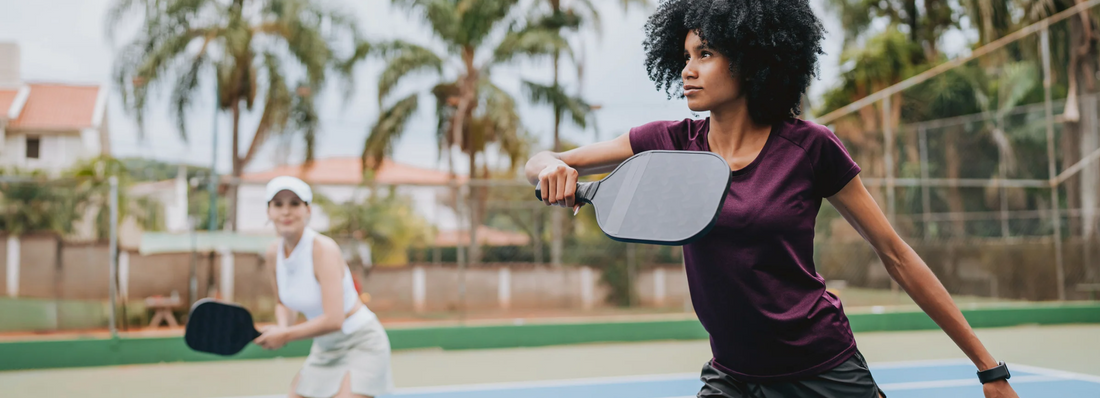
Mastering the Two-Bounce Rule: How to Turn a Rule into a Tactical Advantage
Share
At first glance, the two-bounce rule in pickleball seems like a simple directive meant to slow the game down. But beneath that surface lies one of the most strategically rich aspects of the sport. Mastering this rule transforms a player’s approach to rallies, positioning, and anticipation. It’s not just about compliance; it’s about control. When used deliberately, the two-bounce rule can become a powerful tool that dictates the tempo of play and gives you the upper hand before the rally even begins.
Understanding the Two-Bounce Rule
The rule is straightforward: when a rally begins, the serve must bounce once on the receiver’s side, and the return must bounce once on the server’s side before either team can volley the ball (hit it in the air). After these two bounces occur, players are free to volley or let the ball bounce again.
The purpose of this rule is balance. It prevents the serving team from rushing the net and dominating early, while giving the receiving team a fair opportunity to engage in a rally. Essentially, it’s the sport’s built-in equalizer—a rule that promotes skill over brute strength.
Why the Rule Exists
When pickleball was first created, the founders designed it to be a game of patience and precision. Without the two-bounce rule, points would end too quickly, dominated by servers charging the net. The enforced bounces slow the game momentarily, requiring both teams to demonstrate control and placement rather than aggression alone.
For designers of strategy, this pause creates opportunity. In those first two shots, every subtle choice—from spin to depth to footwork—can determine who takes control of the rally.
Turning Compliance into Strategy
1. The Return of Serve: Setting the Trap
The return of serve is your first chance to seize momentum. Because the serving team must let your return bounce, you have the luxury of dictating their movement. Aim for a deep return, ideally landing close to their baseline. This forces them backward, buying you time to advance toward the kitchen line.
If you return short, the server gains an easy setup for their third shot. But a deep, arcing return compels them to hit upward—making it harder to attack and easier for you to prepare your defense.
Pro Tip: Add a touch of topspin to your return. The extra bounce will push your opponent farther back, creating valuable space for your transition.
2. The Third Shot: The Art of Neutralization
Once the ball has bounced twice, the third shot becomes the pivot point of the rally. The serving team now must transform from defense to offense in a single motion. The most effective way to do this is through the third shot drop—a soft, controlled shot that lands gently in the opponent’s kitchen.
This drop neutralizes the receiver’s positional advantage and resets the rally into a balanced exchange at the net. The two-bounce rule makes this delicate shot essential because it grants both sides a structured moment before volleys begin.
Mastering the drop means learning to strike with touch rather than power, using an open paddle face and a relaxed wrist. Done correctly, it forces your opponent to hit upward again, flipping control back to you.
3. Reading the Rally’s Rhythm
The two-bounce rule introduces a natural rhythm to every point—a slow build followed by an explosion of quick exchanges. Great players use that rhythm to their advantage. They move deliberately during the first two shots, conserving energy and scanning for weaknesses.
By anticipating where the second bounce will occur, you can pre-position yourself for the transition zone, arriving at the net with balance and readiness. The secret is to treat those opening shots as a chess opening, not just a formality.
Common Mistakes and How to Avoid Them
Rushing the Net Too Early
New players often sprint forward immediately after serving, forgetting they must wait for the return to bounce. This mistake leaves them out of position and vulnerable. Instead, advance in stages—step forward after your serve, pause to observe the return, then close in after the second bounce.
Overpowering the Return
While it’s tempting to hammer the return, overhitting often causes the ball to fly long or bounce high, inviting an aggressive third shot. Prioritize control and placement over pace. A smooth, deep return does more damage than a blistering one.
Misjudging Spin and Bounce
At higher levels, players manipulate spin to challenge opponents’ timing. Topspin causes the ball to jump higher, while backspin makes it skid low. Study how your opponent hits their shots during the two-bounce exchange and adjust your paddle angle accordingly.
How Professionals Exploit the Rule
Elite pickleball players treat the two-bounce rule as a tactical dance. They rarely waste those early exchanges. Instead, they choreograph them: a deep return, a soft drop, a graceful advance to the kitchen.
By mastering the discipline of restraint, they set themselves up for dominance later in the rally. The true genius of top-level play is not in how hard they hit, but how intelligently they sequence those first few strokes.
Watching professional doubles matches reveals a pattern—every team uses the same rule differently. Some players angle their returns wide to open space, while others target their opponent’s weaker side. Each move during the two-bounce phase is a carefully chosen step toward controlling the net.
Turning Patience into Power
The two-bounce rule rewards composure. It encourages players to slow their instincts and think strategically. Instead of rushing to end the point, the best competitors use the rule to build pressure through controlled precision.
Mastery begins when you see the first two bounces not as limitations, but as opportunities—to reposition, to observe, and to anticipate. Once you internalize that rhythm, you’ll find yourself controlling rallies before your opponent even realizes it.
Conclusion
The two-bounce rule is the spine of pickleball’s unique identity. It levels the field, cultivates strategy, and turns every rally into a contest of intellect as much as athleticism. By embracing its rhythm and using it to shape your movement, you transform a simple restriction into a competitive edge.
In the end, pickleball’s most misunderstood rule is also its most empowering one. Master it, and you’ll find not just better results, but a deeper appreciation for the game’s artistry—where patience, precision, and timing merge into a single, seamless advantage.












